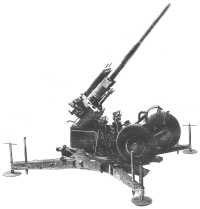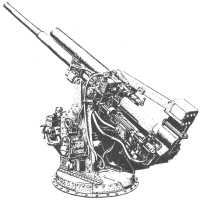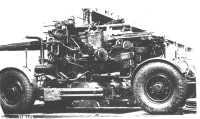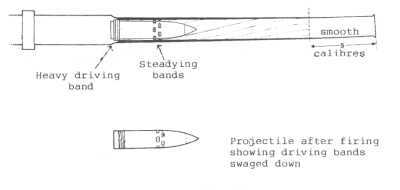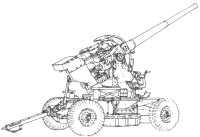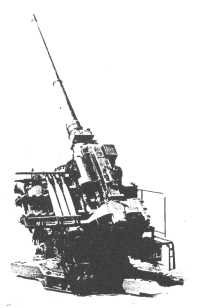|
| |||||||||||||||||||||
QF 3.7-in Heavy Anti-aircraft Gun | |||||||||||||||||||||
The first British equipment designed specifically for the anti-aircraft role, i.e. not a converted field or coast gun, was the QF 3-in 20-cwt. Introduced in March 1914 it was supplied to both Navy and Army, and remained in service until the early years of World War 2. Four equipments on mobile mountings were obtained for the New Zealand Army in 1935 but were cut up and sold as scrap iron after World War 2. The writer obtained the breech mechanism and part of the barrel of one for use as an aid in teaching basic principles of gun construction at the School of Artillery in 1953, but following a change of staff the aid was scrapped in 1958. After World War 1 further development of heavy anti-aircraft equipments virtually ceased in Britain. As well as a lack of money there existed among the diehards a school of thought which maintained that the proper way to combat enemy aircraft was by other aircraft, i.e. the RAF, and that the AA gun had been nothing but a temporary stopgap produced by wartime conditions. Although a 3.7 gun was first proposed in 1928, little progress seems to have been made in the years immediately following. |
Fig. 1: QF 3.7-in heavy anti-aircraft gun on mobile mounting. The Mark 2 was designed for a static mounting for use in fixed defences (see Fig. 2).
| ||||||||||||||||||||
|
But from 1933 great advances were being made in aircraft design and the heights which bombers could achieve - from 20,000 feet (6096 metres) upwards. Bearing in mind the maximum ceiling of the 3-inch 20 cwt was 23,500 feet (7010 m) under ideal conditions, obviously a heavier gun was needed. The 3.7 was introduced in 1937, fortunately allowing enough time for production to get under way before the outbreak of World War 2. It fired a 28-lb (12.72 kg) shell to a ceiling of 32,000 feet (9754 m), a significant improvement on the 3-inch. During the war an automatic fuze-setter (MFS No 11) and an automatic loader were fitted. These not only speeded up the rate of fire, but by eliminating variations in time taken by individuals in loading and fuze-setting, enabled guns to follow data supplied by predictor more closely. Thus the new machinery not only increased the rate of fire from 10 to 20 rpm, but also improved accuracy. Guns so equipped were designated Mark 3A. | Fig. 2: QF 3.7-in gun on static mounting, ie designed to be bolted down to a concrete foundation.
| ||||||||||||||||||||
But as World War 2 progressed, and bombers flew ever higher, still more effective equipment was demanded to cope with them. Experiments with a proposed 4.7-inch gun were not successful so in 1941 a number of Naval QF 4.5-in guns were obtained, the barrels lined down to 3.7, but the original chamber retained so that a 4.5 cartridge could be fired. This combination sent the same 28-lb shell to 45,000 feet (13,776 metres).
To increase the performance of the 4.5/3.7 combination Colonel Probert of the Research Department, Woolwich Arsenal, developed a special barrel in which the rifling gradually decreased in depth from the breech to five calibres from the muzzle where it disappeared altogether and the barrel became smooth-bored. In addition to a heavier driving band the projectile was fitted with 'steadying bands' near the shoulder. The smooth-bore section of the barrel swaged down the driving and steadying bands flush with the surface of the shell, thus improving its ballistic qualities. See Fig. 4 .
The precise ceiling achieved by the Mk 6 gun is not known but is believed to have been over 50,000 feet (15,240 metres). In the latter stages of World War 2 the Allies enjoyed air superiority, so a number of 3.7 guns were converted to fire. in the field role in which they performed satisfactorily - where crest clearance was no problem. The late WO1(SMIG) JT (Terry) Transom and the writer converted a 3.7 at the School of Artillery in 1956. A QF 4.5-in howitzer sight-supporting pintle was welded to the top of the traversing gear column, and on the pintle was attached a 4.5 sight bracket with a dial sight. On the elevation side of the gun a sight clinometer was attached to indicate elevation. The combination worked very well but unfortunately the fire of 1957 which destroyed the 4.5 sight brackets ended further practice. In the end jet-propelled aircraft won the day; they could fly at heights no gun could reach. Thus heavy anti-aircraft guns began to be phased out in 1958. | |||||||||||||||||||||
|
The New Zealand Army received 3.7 guns after the outbreak of World War 2. In 1962 TF anti-aircraft units were disbanded and their guns relegated to other roles. LAA (40-mm) guns were handed over to the Navy, although a need for them still existed in the Army. The 3.7s were issued to Coast Artillery Cadres in Auckland, Wellington, Christchurch and Dunedin to form mobile examination batteries. For this role they were stripped of their automatic fuze-setters and loading gear, so they resembled the originals of 1937. In 1967 Coast Cadres were disbanded and their guns donated to museums, RSAs etc or scrapped. The gun in the Army Museum is one of them. The role of the heavy AA gun has been assumed by the SAM (Surface to Air Missile), with which a number of countries are well-equipped. Where are New Zealand's SAMS? The Germans recognised a good gun when they saw one; after the BEF debacle in France in 1940 they converted to their own use a number of captured 3.7 guns which their detachments had failed to destroy. They even produced ammunition for them. | |||||||||||||||||||||
|
GENERAL DATA:
|
Fig. 6: 'Longhand,' the last of the 3.7s. With automatic ammunition feed, it could reach a rate of fire of 60 rpm. However, within weeks of its being approved, the guided missile made it obsolete. | ||||||||||||||||||||
|
WL Ruffell
Guns at Waiouru | Guns around New Zealand | More equipments | Home | |||||||||||||||||||||
